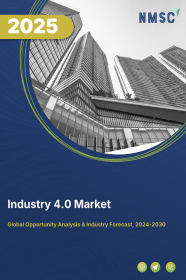
Industry 4.0 Market by Technology (Industrial robots, Industrial Internet of Things (IIoT), Artificial Intelligence (AI) and Machine Learning, Big Data Analytics, Cybersecurity, Advanced Human-Machine Interfaces (HMIs), Additive Manufacturing (3D Printing), Augmented Reality (AR) and Virtual Reality (VR), and Others), and Others - Global Opportunity Analysis and Industry Forecast 2024-2030
US Tariff Impact on Industry 4.0 Market
Trump Tariffs Are Reshaping Global Business
Market Definition
The Industry 4.0 Market size was valued at 115.21 billion in 2023 and is predicted to reach 432.99 billion by 2030 with a CAGR of 20.85% from 2024-2030. Industry 4.0, also known as the Fourth Industrial Revolution, refers to the integration of advanced technologies and automation into various industries to create smarter and more efficient systems. The fourth industrial revolution is characterized by the fusion of physical and digital technologies, such as the Internet of Things (IoT), artificial intelligence (AI), robotics, 3D printing, and big data analytics. These technologies enable machines, devices, and systems to communicate with each other and make autonomous decisions based on real-time data. Industry 4.0 is transforming the way companies operate, from manufacturing and logistics to customer service and marketing. Smart factories equipped with Industry 4.0 technologies are capable of producing highly customized products at lower costs and with greater efficiency. This results in improved productivity, reduced waste, and faster time-to-market.
Market Dynamics and Trends
The industry 4.0 market is driven by the growing demand for automation and digitization in various industries such as manufacturing, healthcare, transportation, and energy. With the rise of global competition and the need to reduce costs and increase productivity, businesses are adopting Industry 4.0 technologies such as the Internet of Things (IoT), machine learning, and artificial intelligence to streamline their operations and gain a competitive edge. Moreover, the increasing adoption of additive manufacturing, also known as 3D printing, further accelerating the industry 4.0 market. Additive manufacturing is a key technology in Industry 4.0 as it enables on-demand, customized production of complex parts and components, with less waste and shorter lead times than traditional manufacturing methods.
Furthermore, the increasing demand for big data analytics to improve decision-making is significantly fuelling the growth of the industry 4.0 market. With the increasing volume, velocity, and variety of data being generated, businesses need advanced analytics tools to make sense of it all and gain insights that can be used to improve their operations, products, and services. Industry 4.0 technologies offer businesses the ability to collect and analyze vast amounts of data in real-time, enabling them to make more informed decisions and respond quickly to changing market conditions.
However, the implementation of industry 4.0 technology requires significant investments in hardware, software, and infrastructure, which can be a barrier for small and medium-sized enterprises (SMEs) that may not have the financial resources to make such investments, thus it may restrain the growth of the market.
On the other hand, the integration of AI and IoT with Industry 4.0 is expected to create significant growth opportunities for the market in the future. AI can assist in automating and optimizing various processes, while IoT can provide real-time data and insights for better decision-making. Combining these technologies with Industry 4.0 can lead to significantly more efficient and productive operations, as well as improved quality control and predictive maintenance.
Market Segmentation and Scope of Study
The global industry 4.0 market is segmented on the basis of technology, application, industry vertical and region. Based on technology, the market is classified into industrial robots, industrial Internet of Things (IIoT), artificial intelligence (AI) and machine learning, big data analytics, Cybersecurity, Advanced Human-Machine Interfaces (HMIs), additive manufacturing (3D Printing), augmented reality (AR) and virtual reality (VR), and others. On the basis of application, the market is categorized into predictive maintenance, quality control and optimization, inventory management, supply chain management, smart manufacturing, asset tracking and management, and others. Based on industry vertical the market is categorized into, manufacturing, energy & utilities, automotive, oil & gas, aerospace & defense, electronics, and others. Geographical breakdown and analysis of each of the aforesaid classifications include regions comprising of North America, Europe, Asia-Pacific, and RoW.
Geographical Analysis
North America dominates the global industry 4.0 market share and is potently expected to remain dominant in the market throughout the forecast period. This is attributed the supportive regulatory environment and government initiatives aimed at promoting digital transformation and advanced manufacturing practices. In April 2022, United States Agency for International Development launched initiative for the digital transformation of 200 micro, small, and medium-sized enterprises (MSMEs). This initiative aims to facilitate the adoption of digital technologies among MSMEs, potentially including solutions for optimizing processes related to anti-foaming agents’ production or usage. Programs offering tax incentives, grants, and funding for research and development in emerging technologies encourage businesses to embrace industry 4.0 solutions for improved competitiveness and sustainability.
Moreover, the presence of key market players such as Honeywell International Inc., Rockwell Automation, Inc., and Emerson Electric Co. that are adopting various strategies including partnership is significantly fuelling the industry 4.0 market in the region. For instance, in March 2023, Rockwell Automation announced a strategic investment in READY Robotics, aiming to streamline robot implementation processes. This partnership underscores the company's commitment to advancing automation solutions in the industry 4.0 market.
On the other hand, Asia Pacific shows substantial growth in the global industry 4.0 market owing to the e-commerce development in the Asia Pacific region driven by the rising e-commerce industry in the Asia-Pacific region. According to the International Trade Administration, China is the largest e-commerce market globally as it reached USD 2.29 trillion in 2020 and is expected to reach USD 3.56 trillion by the end of 2024. The rapid growth of e-commerce has heightened demand for efficient logistics, supply chain management, and manufacturing processes to meet the increasing volume of online orders and consumer expectations for fast delivery. By embracing Industry 4.0 practices, e-commerce companies can improve productivity, reduce costs, and enhance customer satisfaction, thus driving further growth in the industry 4.0 market.
Also, the growing adoption of industrial robotics across various industries is driving the industry 4.0 market in region. Countries such as Japan, China, South Korea, and India are embracing automation and advanced manufacturing technologies to enhance productivity and efficiency. According to the Information Technology and Innovation Foundation Report of March, 2024 depicts that China is the leading market of industrial robots by volume. China had installed 18% more industrial robots per manufacturing workers. Around 52% industrial robots of the world are installed in China reflecting about the increasing adoption of industrial robots in manufacturing sector. Industrial robots play a crucial role in enabling Industry 4.0 initiatives by automating tasks, optimizing production processes, and improving quality control. As businesses seek to modernize their operations and stay competitive in the global market, the demand for Industry 4.0 solutions, including robotics, continues to rise in the Asia Pacific region.
Competitive Landscape
The industry 4.0 market includes several market players such as ABB Ltd., Siemens AG, Cognex Corporation, Schneider Electric SE, Honeywell International Inc., Emerson Electric Co., Rockwell Automation, Inc., General Electric Company, Robert Bosch GmbH, and Cisco Systems Inc. among others. These market players are adopting various strategies including product launches, acquisition and collaboration to maintain their dominance in the global industry 4.0 market.
For instance, in January 2023, Siemens Digital Industries Software launched eXplore Live at The Smart Factory in Wichita, Kansas. This is an experience center convened by Deloitte that combines an ecosystem of world-leading organizations with business strategy and cutting-edge technology to demonstrate Industry 4.0.
Also, in February 2022, IBM acquired Sentaca, one of the leading telco consulting services and solutions providers. This acquisition will accelerate IBMs hybrid cloud consulting business, adding critical skills to help Communication Service Providers (CSPs) and media giants modernize on multiple cloud platforms, innovate, and transform their businesses. Moreover, in February 2021, Siemens and Red Hat collaborated to provide hybrid cloud solutions for businesses to deliver an open, flexible and more secure solution for manufacturers and plant operators to drive real-time value from operational data.
KEY BENEFITS
-
The report provides quantitative analysis and estimations of the industry 4.0 market from 2024 to 2030, which assists in identifying the prevailing market opportunities.
-
The study comprises a deep dive analysis of the industry 4.0 market including the current and future trends to depict prevalent investment pockets in the market.
-
Information related to key drivers, restraints, and opportunities and their impact on the industry 4.0 market is provided in the report.
-
Competitive analysis of the players, along with their market share is provided in the report.
-
SWOT analysis and Porters Five Forces model is elaborated in the study.
-
Value chain analysis in the market study provides a clear picture of roles of stakeholders.
KEY MARKET SEGMENTS
By Technology
-
Industrial Robots
-
Industrial Internet of Things (IIoT)
-
Artificial Intelligence (AI) and Machine Learning
-
Big Data Analytics
-
Cybersecurity
-
Advanced Human-Machine Interfaces (HMIs)
-
Additive Manufacturing (3D Printing)
-
Augmented Reality (AR) and Virtual Reality (VR)
-
Others
By Application
-
Predictive Maintenance
-
Quality Control and Optimization
-
Inventory Management
-
Supply Chain Management
-
Smart Manufacturing
-
Asset Tracking and Management
-
Others
By Industry Vertical
-
Manufacturing
-
Energy & Utilities
-
Automotive
-
Oil & Gas
-
Aerospace & Defense
-
Electronics
-
Others
By Region
-
North America
-
The U.S.
-
Canada
-
Mexico
-
-
Europe
-
The UK
-
Germany
-
France
-
Italy
-
Spain
-
Denmark
-
Netherlands
-
Finland
-
Sweden
-
Norway
-
Russia
-
Rest of Europe
-
-
Asia Pacific
-
China
-
Japan
-
India
-
South Korea
-
Australia
-
Indonesia
-
Singapore
-
Taiwan
-
Thailand
-
Rest of Asia Pacific
-
-
RoW
-
Latin America
-
Middle East
-
Africa
-
REPORT SCOPE AND SEGMENTATION:
|
Parameters |
Details |
|
Market Size in 2023 |
USD 115.21 Billion |
|
Revenue Forecast in 2030 |
USD 432.99 Billion |
|
Growth Rate |
CAGR of 20.85% from 2024 to 2030 |
|
Analysis Period |
2023–2030 |
|
Base Year Considered |
2023 |
|
Forecast Period |
2024–2030 |
|
Market Size Estimation |
Billion (USD) |
|
Growth Factors |
|
|
Countries Covered |
28 |
|
Companies Profiled |
10 |
|
Market Share |
Available for 10 companies |
|
Customization Scope |
Free customization (equivalent up to 80 working hours of analysts) after purchase. Addition or alteration to country, regional, and segment scope. |
|
Pricing and Purchase Options |
Avail customized purchase options to meet your exact research needs. |
KEY PLAYERS
-
ABB Ltd.
-
Siemens AG
-
Cognex Corporation
-
Schneider Electric SE
-
Honeywell International Inc.
-
Emerson Electric Co.
-
Rockwell Automation, Inc.
-
General Electric Company
-
Robert Bosch GmbH
-
Cisco Systems Inc.

















 Speak to Our Analyst
Speak to Our Analyst




















